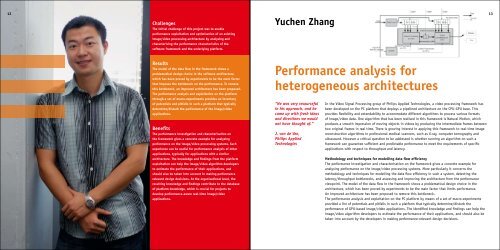Software Technology - Stan Ackermans Institute - TU/e
Software Technology - Stan Ackermans Institute - TU/e
Software Technology - Stan Ackermans Institute - TU/e
You also want an ePaper? Increase the reach of your titles
YUMPU automatically turns print PDFs into web optimized ePapers that Google loves.
12<br />
Challenges<br />
The initial challenge of this project was to enable<br />
performance exploitation and optimisation of an existing<br />
image/video processing architecture by analysing and<br />
characterising the performance characteristics of the<br />
software framework and the underlying platform.<br />
Results<br />
The model of the data flow in the framework shows a<br />
problematical design choice in the software architecture,<br />
which has been proved by experiments to be the main factor<br />
that imposes the bottleneck on the performance. To remove<br />
this bottleneck, an improved architecture has been proposed.<br />
The performance analysis and exploitation on the platform<br />
through a set of macro-experiments provides an inventory<br />
of potentials and pitfalls in such a platform that typically<br />
determine/disturb the performance of the image/video<br />
applications.<br />
Benefits<br />
The performance investigation and characterisation on<br />
the framework gives a concrete example for analysing<br />
performance on the image/video processing systems. Such<br />
experience can be useful for performance analysis of other<br />
applications, typically for applications with a similar<br />
architecture. The knowledge and findings from the platform<br />
exploitation can help the image/video algorithm developers<br />
to estimate the performance of their applications, and<br />
should also be taken into account in making performance<br />
relevant design decisions. At the organisational level, the<br />
resulting knowledge and findings contribute to the database<br />
of platform knowledge, which is crucial for projects to<br />
develop performance-aware real-time image/video<br />
applications.<br />
Yuchen Zhang<br />
Performance analysis for<br />
heterogeneous architectures<br />
“He was very resourceful<br />
in his approach, and he<br />
came up with fresh ideas<br />
and directions we would<br />
not have thought of.”<br />
J. van de Ven,<br />
Philips Applied<br />
Technologies<br />
In the Video Signal Processing group of Philips Applied Technologies, a video processing framework has<br />
been developed on the PC platform that deploys a pipelined architecture on the CPU-GPU base. This<br />
provides flexibility and extendability to accommodate different algorithms to process various formats<br />
of image/video data. One algorithm that has been realised in this framework is Natural Motion, which<br />
produces a smooth impression of moving objects in videos by producing the intermediate frames between<br />
two original frames in real time. There is growing interest in applying this framework to real-time image<br />
reconstruction algorithms in professional medical scanners, such as X-ray, computer tomography and<br />
ultrasound. However a critical question to be addressed is whether running an algorithm on such a<br />
framework can guarantee sufficient and predictable performance to meet the requirements of specific<br />
applications with respect to throughput and latency.<br />
Methodology and techniques for modelling data flow efficiency<br />
The performance investigation and characterisation on the framework gives a concrete example for<br />
analysing performance on the image/video processing systems. More particularly it concerns the<br />
methodology and techniques for modelling the data flow efficiency in such a system, detecting the<br />
latency/throughput bottlenecks, and assessing and improving the architecture from the performance<br />
viewpoint. The model of the data flow in the framework shows a problematical design choice in the<br />
architecture, which has been proved by experiments to be the main factor that limits performance.<br />
An improved architecture has been proposed to remove this bottleneck.<br />
The performance analysis and exploitation on the PC platform by means of a set of macro-experiments<br />
provided a list of potentials and pitfalls in such a platform that typically determine/disturb the<br />
performance of GPU-based image/video applications. The identified knowledge and findings can help the<br />
image/video algorithm developers to estimate the performance of their applications, and should also be<br />
taken into account by the developers in making performance-relevant design decisions.<br />
13



